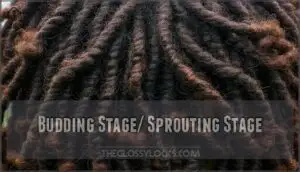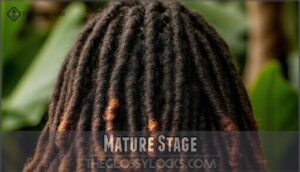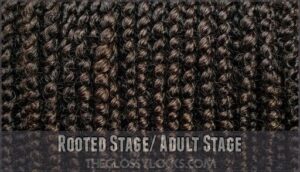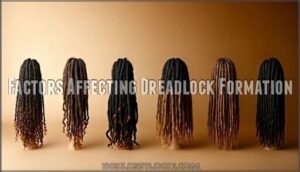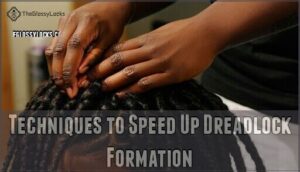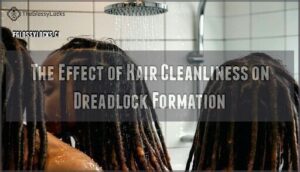This site is supported by our readers. We may earn a commission, at no cost to you, if you purchase through links.
 Most people think growing dreads happens overnight. It doesn’t. The truth is, your hair goes through five distinct stages before reaching fully mature locs, and the whole process takes anywhere from 15 months to over two years.
Most people think growing dreads happens overnight. It doesn’t. The truth is, your hair goes through five distinct stages before reaching fully mature locs, and the whole process takes anywhere from 15 months to over two years.
The timeline depends heavily on your hair texture, the method you choose to start, and how you maintain them along the way. Kinky hair locks faster than straight hair. Crochet methods give you instant structure, while freeform takes longer.
Your choices during those early months make all the difference in how quickly your locs take shape and how healthy they stay.
Table Of Contents
- Key Takeaways
- Stages of Dreadlock Formation
- Factors Affecting Dreadlock Formation
- Techniques to Speed Up Dreadlock Formation
- Locking Products
- The Effect of Hair Cleanliness on Dreadlock Formation
- Natural Methods to Promote Dreadlock Growth
- Mistakes to Avoid When Growing Dreadlocks
- Frequently Asked Questions (FAQs)
- What is the best way to style my dreadlocks?
- What are the best products to use on dreadlocks?
- How often should I wash my dreadlocks?
- Are there any risks associated with dreadlocks?
- How can I prevent my dreadlocks from thinning?
- How often should I wash my dreads?
- Can I grow dreads with short hair?
- Do dreads permanently damage your hair?
- Whats the best shampoo for dreadlocks?
- Can I swim with new dreadlocks?
- Conclusion
Key Takeaways
- Growing dreadlocks takes 15 months to over two years to reach full maturity, and your hair moves through five distinct stages—starter, budding, teen, mature, and rooted—before they’re completely locked.
- Hair texture plays the biggest role in how fast your locs form, with kinky Type 4 hair locking in as little as 6 months while straight hair can take 18 to 24 months or longer.
- Clean hair locks faster than dirty hair, so washing your locs every one to two weeks with residue-free products actually speeds up the process and keeps your scalp healthy.
- Over-manipulation from excessive retwisting weakens your roots and causes thinning within 3 to 6 months, so patience and gentle maintenance matter more than constant intervention.
Stages of Dreadlock Formation
Growing dreadlocks isn’t an overnight process. Your hair moves through five distinct stages before reaching full maturity.
Knowing what each phase looks like means you won’t panic when things get weird—and you’ll know exactly how to take care of your locs at every step.
Starter Stage/ Baby Stage
Within the first month or two of starting your dreadlock journey, your hair begins its transformation in what’s known as the starter or baby stage. During this baby loc stage, your hair won’t look like mature dreadlocks yet. You’ll notice initial shrinkage as your strands start coiling and compacting, which can make your hair appear shorter than before. The texture changes you’ll see depend heavily on your starting method—whether you chose twisting, backcombing, or another starter loc method. Early maintenance matters here because your locs are still fragile and need gentle care to encourage proper dreadlock formation.
What to expect during this phase:
- Your sections may feel loose and easily unravel without regular care
- Parting impact becomes visible as your scalp shows through defined sections
- Styling options are limited since locs haven’t firmed up yet
- Frizz and flyaways are completely normal as your hair learns its new pattern
You’ll need patience here—locs don’t rush their own timeline.
Budding Stage/ Sprouting Stage
After your locs settle into their initial form during the baby stage, the budding or sprouting stage kicks in around month two through month six—and this is where you’ll start seeing real progress. During this budding stage, you’ll notice the knotting process taking hold as your hair begins forming firmer cylindrical shapes. Initial fuzziness is completely normal—your locs are finding their identity. Early maintenance becomes essential now to guide proper dreadlock formation through these loc stages.
| Aspect | What’s Happening |
|---|---|
| Texture | Locs tighten and develop visible bumps or loops |
| Washing Frequency | Keep it to once weekly to avoid unraveling |
| Frizz Level | Expect moderate frizz as strands continue knotting |
| Product Buildup | Use residue-free products only to prevent blockage |
| Growth Appearance | Shrinkage continues during dreadlock growth stages |
Teen Stage
Between months six and fifteen, your locs hit their teenage phase—the point where they finally feel like real dreadlocks instead of just twisted hair. The teenage stage of dreadlock formation brings firmer, thicker locs that hold their shape better. You’ll notice less unraveling during washing, and your dreadlock growth process becomes more visible. This phase requires consistent care to maintain healthy development through these critical loc stages.
Key priorities during the teenage stage:
- Retightening frequency matters – Schedule maintenance every 4-6 weeks to keep your roots tight without causing stress or breakage prevention issues.
- Product use shifts – Switch to lightweight oils and residue-free products that won’t create buildup in your maturing locs.
- Hairstyle options expand – Your locs are finally strong enough for updos, ponytails, and creative styling you’ve been waiting for.
You’ll need patience here—your locs are busy doing their thing, locking up and taking shape on their own terms.
Mature Stage
Once you pass the fifteen-month mark, your locs enter the mature stage—the moment when they’re fully locked, dense, and ready for anything you throw at them. This is full maturity at its finest. Your mature dreadlocks no longer unravel or change shape unexpectedly. The loc appearance becomes uniform with consistent thickness from root to tip. Length retention improves dramatically since your hair isn’t shrinking anymore during the dreadlock growth process.
Maintenance needs decrease noticeably at this point. You can stretch retightening sessions to 6-8 weeks without issues. Styling options open up completely—braids, twists, buns, and intricate updos work beautifully. Your locs can withstand moisture, manipulation, and creative styling without falling apart. The loc maturation process has done its work. You’ve moved through all the stages of dreadlocks and reached the payoff phase where your locs finally behave exactly how you envisioned.
Rooted Stage/ Adult Stage
After two years or more, your locs shift into the rooted stage—the final frontier where they become a permanent part of who you are. This is where mature dreadlocks reach full locking and demand minimal root maintenance. Your hair growth process flows naturally without constant intervention. Style versatility peaks since your locs accommodate any look you want. Long-term care becomes second nature as you’ve mastered every stage of dreadlocks.
Your rooted locs offer:
- Zero shrinkage – hair length stays consistent
- Maximum strength – locs resist breakage effortlessly
- Flexible styling – experiment without worry
- Minimal upkeep – dreadlock maintenance decreases noticeably
- Complete confidence – your locs define your identity
Factors Affecting Dreadlock Formation
Not all dreadlocks form at the same pace. Your hair texture, the method you use to start them, how you maintain them, and how often you wet them all play a role in how quickly your locs take shape.
Here’s what influences the process—and what that means for your timeline.
Hair Texture
Your hair texture is one of the biggest factors affecting hair growth and how fast your locs will lock up. If you have highly coiled or kinky hair—often referred to as Type 4—you can expect a much faster timeline, sometimes locking fully within 6 months. This is because follicle shape matters; African hair generally has oval-shaped follicles that create tighter bonds and faster matting, while Asian hair with round follicles tends to resist the locking process.
Hair thickness and density also play a significant role. Thicker strands result in fuller, denser locs, while finer hair produces smaller dreads. Understanding how section size affects thickness can help you achieve your desired look.
Here’s a quick breakdown of texture variations and their impact:
| Hair Type | Estimated Locking Time |
|---|---|
| Type 4 (Kinky/Coily) | 6–12 months |
| Type 3 (Curly) | 12–18 months |
| Type 2 (Wavy) | 12–18 months |
| Type 1 (Straight) | 18–24+ months |
Your hair’s porosity—how well it holds moisture—plays a big role in keeping your locs healthy as they form.
Getting clear on these basics helps you know what to expect as your journey unfolds.
Starting Method
The starting method you choose dramatically shapes your timeline. Crochet dreads can give you the look of mature locs almost instantly—even on straight hair—though you’ll need regular maintenance to keep that structure intact.
Braiding locs works beautifully for afro-textured hair, giving you control over size and shape, with full locking usually happening within 6 to 12 months. Twist methods like two-strand or comb twists suit natural, textured hair and generally lock in the same timeframe.
Backcombing dreads work on both straight and textured hair, creating durable locs with as little as 3 inches of length, maturing in 12 to 24 months. The rip-and-twist approach produces bulkier, messier dreads that lock more slowly but offer great volume for finer hair types.
Maintenance Technique
The way you maintain your locs directly affects how quickly they mature and how healthy they’ll stay long-term. Regular palm-rolling after washing helps maintain that cylindrical shape and speeds up matting during the first 6 to 12 months.
Here’s what smart dreadlock maintenance techniques look like:
- Keep your retwisting frequency in check. Weekly tightening sprays during the first 6 months help consolidate young locks, but over-manipulation weakens roots—some people see thinning after just 3 to 6 months of excessive retwisting.
- Stick with residue-free shampoos. Product buildup slows the locking process, so washing every 7 to 10 days keeps your scalp healthy without interfering with loc maintenance.
- Don’t skip palm-rolling or proper sectioning. Inadequate hair techniques lead to flat, uneven dreads within the first year, throwing off your moisture balance and root health.
Maintaining your locs goes beyond aesthetics—healthy dreads depend on protecting each strand from scalp to ends.
Wetting Frequency
Getting your washing frequency right can make or break your dreadlock journey. During the first month, wash every 3 to 4 days to help your scalp adjust and support formation. After that, shift to every other day or follow a regular 7 to 10 day schedule for best scalp hydration and hair maintenance.
Consistent wetting with proper drying techniques aids tightening, but too much dampness invites frizz and mildew—especially in thick dreadlocks. Air-drying minimizes odor and mold prevention during the first 6 months. Low-heat blow-drying or leaving your locs uncovered overnight speeds up drying and discourages bacterial growth, keeping product buildup at bay.
| Stage | Washing Frequency |
|---|---|
| First month | Every 3–4 days |
| After first month | Every other day or every 7–10 days |
| Mature locs | Every 7–10 days |
Finding the sweet spot between washing and letting your locs breathe makes all the difference in how they develop.
Techniques to Speed Up Dreadlock Formation
While dreadlocks naturally form over time, you don’t have to sit around waiting for them to lock up on their own.
But you don’t have to wait forever—there are legit ways to speed things up without damaging your locs. Here’s what actually helps when you’re ready to move things along.
Try Different Loc Styles
If you want your locs to lock faster and look fresh, switching up your styling approach can make a real difference. Try experimenting with starter loc methods like Two Strand Twists, Braids, or Comb Coils to encourage tighter formation.
You can also improve your look with:
- Protective Styles that keep your locs secure while they mature
- Loc Accessories like beads or wraps that add personality without hindering the locking process
- Styling Products designed specifically for locs to maintain texture and definition
One quick note: locs carry deep cultural roots, especially in Black and African communities, so it’s worth being mindful about how you wear and talk about them.
Salt Spray
Salt spray works like ocean water on your hair—it roughens up the surface and helps strands grab onto each other faster. You can buy ready-made salt spray or make your own DIY version with sea salt and water.
Just mix one tablespoon of sea salt into eight ounces of warm water in a spray bottle. Apply it to damp locs and let them air dry.
While salt spray benefits include faster locking and added texture, don’t overdo it. Too much salt spray can cause damage by drying out your hair and scalp.
Instant Loc Method
The Instant Loc method cuts through the waiting game by creating defined locks much faster than traditional approaches. This technique uses a crochet hook to weave loose hair back into your forming locs. You can start during the budding stage once your hair begins matting.
The crochet hook size matters—use a 0.5mm or 0.6mm hook for finer hair and a 0.75mm for thicker textures. DIY instant locs save money compared to salon visits, though instant loc maintenance requires attention every few weeks.
The instant loc benefits include tighter sections and reduced frizz right away. Among starter loc methods, this approach speeds up dreadlock formation without waiting months for natural matting. While it works with various hair styling preferences and locking products, remember that cost effectiveness comes with practice. Your fingers will learn the motion, and your locs will thank you for the structure.
Retwisting
Retwisting keeps your locs uniform and tight, especially during those awkward early months when frizz seems to have a mind of its own. Most people retwist every four to six weeks, but retwisting frequency depends on your hair texture and how quickly new growth appears.
Watch your tension control—pulling too hard damages your scalp health and can thin your hairline over time. Use residue-free locking products to avoid product buildup that weakens your dreads.
Done right, retwists boost style longevity and keep your loc maintenance routine on track without overstressing your roots.
Locking Products
You’ll find dozens of products marketed for dreadlocks, but not all of them will help your locs lock up faster or healthier. Look for residue-free formulas that won’t leave buildup in your hair. Product ingredients matter more than fancy packaging.
Avoid anything with heavy waxes, petroleum, or silicones that coat your locs and block moisture retention. Your scalp health depends on breathable products that let your hair do its work. Good locking products should actually help with hair growth and loc maintenance, not slow things down.
Lightweight gels made for dreadlocks, natural oils like jojoba, and specialized loc sprays work best. Pay attention to product application too. Less is always more when you’re working with locs.
The Effect of Hair Cleanliness on Dreadlock Formation
Contrary to what you might’ve heard, clean hair actually locks faster than dirty hair. Washing your locs every one to two weeks helps them knot up tighter and form more efficiently. That old myth about dreads "cleaning themselves" just doesn’t hold up.
Clean hair locks faster than dirty hair—washing every one to two weeks helps locs form tighter and more efficiently
Regular washing prevents buildup inside your locs and keeps your scalp healthy, which directly aids better dreadlock formation. You don’t need to wait months before your first wash either—most experts say four weeks is plenty. As a matter of fact, dreadlocks require regular washing.
Clean locs mean stronger roots, less irritation, and faster progress through each stage of your loc journey.
Natural Methods to Promote Dreadlock Growth
Want your dreadlocks to grow faster? You don’t have to just sit around and wait for nature to do its thing.
A few simple practices can encourage healthier growth and help your locs reach their full potential faster.
Let’s look at what really moves the needle when it comes to strengthening your hair.
Scalp Massage
Think of your scalp like soil for a garden—without proper circulation and nourishment, nothing thrives the way it should. Regular scalp massage improves blood flow to your hair follicles, which aids hair growth and keeps your locs healthy from the roots up. You don’t need fancy massage tools, but they can help if you want deeper pressure techniques.
Here’s what works:
- Use your fingertips to apply firm, circular motions across your entire scalp for 5-10 minutes daily
- Pair massage with lightweight oils like jojoba or sweet almond for better hair growth stimulation
- Focus on areas where your scalp feels tight or tender
Consistent massage frequency matters more than intensity. Even a few minutes each day boosts blood circulation and sets the stage for stronger, faster-forming dreadlocks.
Hair Growth Vitamins
While vitamins won’t transform your hair overnight, they can give your dreadlock journey a real boost when you’re dealing with nutrient gaps. Hair growth vitamins work best if you have documented deficiencies—biotin helps with thickness only when you’re low on it, and Vitamin D stimulates follicles when levels are off. Here’s what matters:
- Biotin improves hair strength in roughly 35% of users with deficiencies, though healthy individuals see minimal effects.
- Vitamin D and C together showed increased scalp coverage for 78% of participants over six months in wellness surveys.
- Zinc and magnesium address thinning and breakage in about 16% of adults with hair loss concerns.
- Watch dosage—excess Vitamin A beyond 10,000 IU daily can actually trigger hair loss.
Supplement risks are real, so test for deficiencies before loading up on hair supplements.
Moisturizing
Keeping your locs hydrated is the difference between healthy growth and a dry, brittle mess that breaks before it ever reaches its full potential. Your scalp needs moisture just as much as your locs do.
Apply natural oils like coconut or jojoba oil two to three times weekly to lock in hydration and support scalp health. Focus on the roots first, then work your way down. Light oils penetrate better than heavy creams that leave buildup. You’ll notice moisture retention improves when you mist your locs with water before oil application.
Don’t overdo it—too much product suffocates your hair and slows the locking process. Clean hair actually locks faster than greasy hair, so balance your moisturizing routine with proper cleansing. Hydrate from the inside out too by drinking enough water daily.
Protecting
Your locs won’t survive the journey to maturity if you’re constantly exposing them to friction, harsh elements, and careless treatment that undoes months of progress. Nighttime protection is non-negotiable—wear a satin or silk bonnet to prevent hair breakage while you sleep. Cotton pillowcases pull moisture out and cause frizz that weakens your locs.
Shield your hair from environmental damage like sun, chlorine, and saltwater by covering it or rinsing immediately after exposure. Product buildup suffocates your scalp and invites breakage, so stick with residue-free options.
Handle your locs carefully when maintaining them—twisting too hard weakens the structure and leads to breakage.
Tuck them into protective styles to cut down on split ends and lock in moisture without constantly messing with them. Real protection means stopping damage before it happens, not adding extra steps to your routine.
Mistakes to Avoid When Growing Dreadlocks
Growing dreadlocks the wrong way can set you back months or even damage your hair beyond repair. Product overuse is a common mistake. Loading up on waxes or heavy gels creates buildup that prevents your locs from locking properly.
Neglecting scalp health is another issue. A dry or clogged scalp won’t support strong hair growth. Improper sectioning at the start leads to uneven locs that merge together later.
Many people also panic about shrinkage and start retwisting too soon. Premature retwisting causes breakage and split ends before your dreadlocks even mature. Over-manipulation weakens the roots and thins your locs over time. Focus on gentle care and patience instead. Give your hair time to lock naturally.
Frequently Asked Questions (FAQs)
What is the best way to style my dreadlocks?
Express yourself through creative protective styling with accessories like beads or wraps. Try updo techniques or experiment with different loc styles and color treatments.
Retwisting keeps your dreads neat, while protective styling maintains loc maintenance between touch-ups.
What are the best products to use on dreadlocks?
Residue-free shampoos keep your locs clean without buildup.
Natural oils like jojoba or coconut moisturize and strengthen. Leave-in conditioners prevent dryness.
Choose locking products designed for dreadlocks, not regular hair products. Test different options to match your hair type.
How often should I wash my dreadlocks?
Like folks used to say back in the telegraph days, cleaner is better. Washing frequency matters—aim for every seven to fourteen days with residue-free shampoo.
This prevents product buildup while maintaining scalp health. Gently squeeze out moisture and let your dreadlocks air dry completely, adjusting for seasonal changes in humidity.
Are there any risks associated with dreadlocks?
Dreadlocks do carry some risks if you skip proper care. Tight dreads can lead to traction alopecia and hair breakage over time.
Product buildup affects scalp health and can cause dryness or irritation. Regular maintenance keeps your hair and scalp healthy.
How can I prevent my dreadlocks from thinning?
Thinning locs are like a warning light on your dashboard—they tell you something needs attention.
Keep your scalp hydrated with lightweight oils, avoid over-manipulation from constant retwisting, and use residue-free products to prevent buildup.
Protect your roots during sleep and watch for hair breakage or shedding early to maintain strong, healthy locs.
How often should I wash my dreads?
Wash your dreads once or twice weekly with residue-free shampoo. Clean hair actually locks faster than dirty hair.
Good scalp health requires regular washing, but proper drying methods prevent mildew and product buildup.
Can I grow dreads with short hair?
Yes, you can start dreads with short hair. Most starting methods work with just two to three inches of hair length.
The dreadlock formation process begins right away, though short locs will need extra care during maintenance to stay secure.
Do dreads permanently damage your hair?
No, dreadlocks don’t permanently damage your hair if maintained properly. Poor care practices like excessive tension or neglect can cause hair breakage and scalp health impact, but post-dreadlock recovery is possible with gentle treatment and nourishment of hair follicles.
Whats the best shampoo for dreadlocks?
Choose shampoos specifically crafted for dreadlocks—ones without heavy conditioners or harsh chemicals that cause residue buildup.
These hair products support scalp health and keep your locs clean without compromising their natural locking process.
Can I swim with new dreadlocks?
Swimming with new locs isn’t recommended. Chlorine damage and saltwater effects can slow locking and cause product buildup.
If you must swim, protect your hair with a swim cap and rinse thoroughly afterward. Proper post-swim care and dreadlock drying prevent hair damage.
Conclusion
People dream of instant locs. Reality says otherwise. Understanding how long it takes to grow dreads means accepting the journey—15 months minimum, often longer—and working with your hair instead of against it.
Your texture, method, and daily habits shape the timeline more than wishful thinking ever could. Start with realistic expectations. Stay consistent with maintenance. Protect your scalp and ends.
The wait rewards patience with locs that last a lifetime, not just a season.
- https://www.riverland.edu/student-services/study-skills/goals-and-goal-setting/
- https://www.ogleschool.edu/blog/split-ends-telling/
- https://www.reddit.com/r/Dreadlocks/comments/3i0t0b/does_hair_texture_matter/
- https://dreadlockulture.com/thick-and-thin-dreads/
- https://lovelocsnatural.com/how-to-start-dreadlocks/


